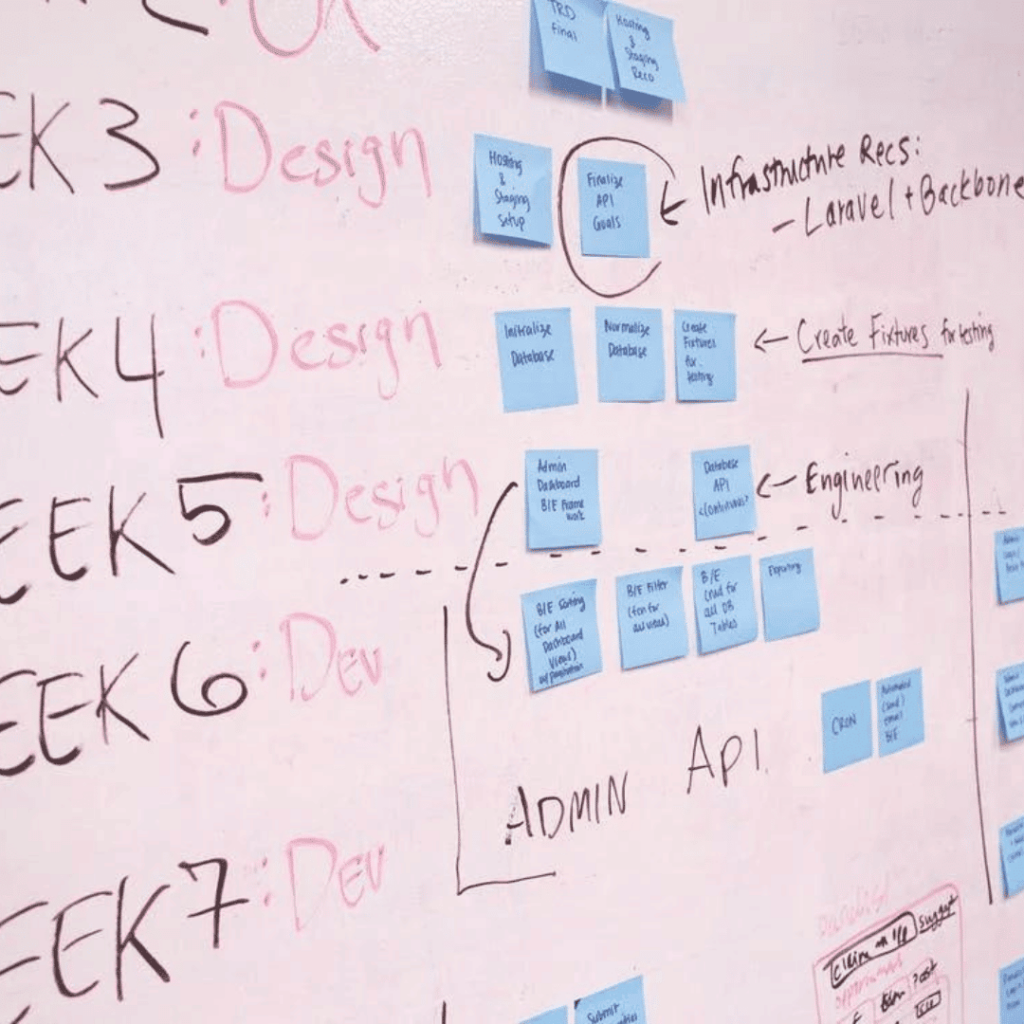Whether you are hiring a new employee or building the tallest building in the world, every project needs a project manager / project lead to lead the project and ensure its success.
Someone who has an eye on every detail in every phase, from planning to completion – in short: project management.
What is project management about?
It’s about getting things done, it’s about knowing exactly what you want to achieve and how long it will take, making sure everyone involved shares and understands those goals before taking the first steps, and that they do too keep doing as the end of whatever project approaches, because successful projects don’t just happen, they’re not just a long list of tasks that need to be accomplished.
Successful projects are mostly masterpieces of planning, organization and communication. A carefully choreographed sequence of events where progress is smooth and steady, one step leads seamlessly to the next, and every potential issue has been considered and addressed.
A successful project needs one or more project managers with the right skills and knowledge working with a well-managed, motivated team with clear roles, responsibilities and reporting lines to bring a project to completion without compromising time, cost or quality.
Project management is a wonderful thing, but it’s easy to forget what the world might be like without it, because project management at its best is virtually invisible.
It’s the absence of problems and the avoidance of failure, but behind every successful project, whether it’s changing the way a company works or organizing a major event, there’s an unsung hero.
The project manager keeps everything and everyone on track so that the desired result can be delivered on time. We support you in all the great work you do every day.
The most important known project management methods (chronologically)
A project management method is understood as the formalized and standardized approach to projects, which in particular prescribes a concrete design of the project management – as a whole or in relation to partial aspects. Well-known project management methods include the project management methods Kanban method, critical path method, SIX SIGMA method, PRINCE2, IPMA and waterfall method, PMBOK, lean management and agile project management methods and the SCRUM method.
Kanban method (1947)
The Kanban method comes from the production process control. The project management method is based entirely on the actual material consumption at the supply and consumption point. Kanban reduces local inventory of inputs in and near production, prepares production operations at Produder to reach 100% performance, and reduces that time by 30%. Increased production time replaces additional work that relies on lighting and production recommendations, develops working time, for example, the ability to make long-term decisions, and leads to adjustments to the next level of integration before a fundamental start is required. As part of the industry’s most productive system, the Kanban project management method aims to play a key role for the automotive industry and others to improve this market fast enough. The company shortened the maximum time allowed.
Critical path project management method (1950s)
The project management method of the critical path (English Critical Path Method, CPM) belongs to the project management methods for project planning. It was developed by American engineer and entrepreneur DuPont in the 1950s. This project management method is based on the assumption that the duration of a project is determined by the length of its critical paths. The critical paths are those paths that take the longest for the project and thus have the greatest importance for the overall result. The critical path method can be used to create schedules that can be used to determine whether a project can be completed on time.
The method is based on the idea that each project consists of a series of interdependent activities (Step 1, Step 2, Step 3, etc.). The duration of each step depends on the duration of the previous steps, as well as the resources (time, money, materials) required to perform it. This critical path project management method can therefore be used to calculate when which step should start and end in order to achieve the desired result.
This method is also based on the analysis and assessment of risks. It is based on the principle of statistical significance based on the assumption that there are no coincidences in a project. Each event has its origin in a previous action. The effects of events, in turn, depend on other events. This results in a network of causalities that describes the path of greatest damage.
SIX SIGMA Method (1970s)
Six Sigma (6σ) is a management system for process improvement and at the same time a method of quality management. The core element is the use of statistical means to describe, measure, analyze, improve and monitor business processes. It is an approach with a complete set of tools to systematically improve or redesign processes. The work breakdown structure for a process improvement project follows the Define-Measure-Analyze-Improve-Control (DMAIC) procedure.
The ultimate goal of Six Sigma programs is to improve a company’s bottom line. You can find more information on this in our “Lean SIX SIGMA” blog post: https://sca.online/?p=35186&preview=true
PRINCE2 – Projects IN Controlled Environments (1975 / 1983 / 1996)
PRINCE2 is a project management method developed with the assistance of the UK Government and is the de facto standard in the UK. It is based on experience from thousands of projects and should help to control them more efficiently. PRINCE2 is now widespread and used by many companies. The method consists of seven phases:
- initialization,
- Planning,
- Execution,
- monitoring and control,
- Diploma,
- resumption and revision control,
each with their own special tasks and methods.
IPMA Individual Competence Baseline (1965 / 1999)
The IPMA Individual Competence Baseline is an instrument of the European project management association of the International Project Management Association (IPMA) and has been a certification body since 1995 to determine the individual competencies of project managers. It is based on the four areas of competence:
- Guide,
- methods and techniques,
- social skills and
- Scientific work.
The baseline can be used both to set up an internal qualification program and to evaluate external project managers. The Individual Competence Baseline is created in four steps:
- Determination of the starting position
- Identification of the fields of competence
- Determination of competence values
- Defining the recommendations for action.
Waterfall Method (1970)
The waterfall project management method is a sequential design process that is most commonly used in software development. It is also referred to as a “traditional” or “linear” development process.
The term “waterfall” was coined by Royce in 1970.
The waterfall model can be viewed as an example of a top-down design, where the specification is created before any coding takes place. This is in contrast to the agile software development approach along agile project management methods with incremental prototyping and frequent feedback from stakeholders. The waterfall project management method is a software development process that includes the sequential phases of requirements gathering, design, coding, testing, and deployment. The requirements must be defined at the beginning and then worked on top-down. This approach can be useful for large projects with many participants. The waterfall model is typically preferred by large companies or organizations that have a lot of resources and want to make sure they don’t miss anything before they start building.
The waterfall method has been criticized for failing to cope with changing requirements and failing to accommodate new technologies. Another major disadvantage of this project management method is that changes to earlier phases are not possible after later ones have been completed.
Lean Management (early 1990s)
The term lean management (in German translations also slim management) refers to the entirety of the thinking principles, methods and procedures for the efficient design of the entire value chain of industrial goods. It is based on the book The Second Revolution in the Auto Industry, which was published in the early 1990s. As scientists at the Massachusetts Institute of Technology , the authors James P. Womack , Daniel T. Jones and Daniel Roos had spent five years studying the differences in the development and production conditions in the automotive industry as part of the International Motor Vehicle Program (IMVP). The principles of a development and production system that is superior in terms of efficiency and quality were worked out and referred to as lean production .
Agile project management methods (2001)
Agile project management methods are based on iterative and incremental development, in which requirements from stakeholders are collected and then incrementally developed in short work cycles, so-called “sprints”. The goal of this process is to provide working software that can be tested early by stakeholders and provide feedback for the next iteration.
The main goal of the process is to create a working product as quickly as possible while ensuring that the product meets the customer’s requirements.
Agile project management
Agile project management was first developed in 2001 by 17 people who came together to create what they called the “Agile Manifesto” and has been used in the software industry since the 1990s. Nowadays it is also applied in other industries such as Manufacturing, Engineering and Construction (AEC).
Some of the advantages of agile project management methods are flexibility, adaptability and simplicity or “agility” as the name suggests. Agile methods are also great for achieving high-quality products because they encourage continuous feedback from customers and stakeholders.
Scrum project management method (1998)
The Scrum method (English for “crowd”) is one of the approaches of project and product management and belongs in particular to the agile methods of software development and is an implementation of lean management for project management. It consists of 3 leadership responsibilities: Product Owner, Developer and Scrum Master.
The term Scrum originally referred to a specific style of software development that involved the use of a board and stick figure sketches of tasks as part of a broader method called the RACI matrix. The word comes from the phrase “Reverse Acronym Cracking Invented by Ken Pugh” referring to his company’s development processes. The acronym RACI stood for Reverse Acronym Cracking Invented by Ken Pugh:
R = Responsible – Who will do what?
A = Accountable – Who checks what has been done?
C = Confirmed – How can we be sure it is correct?
I = Independent — What happens when a person doesn’t know how something works?
In 1998, the Scrum Alliance was formed to standardize usage for a Scrum Team and to provide certification, training, support, and certification resources.
PMBOK (A Guide to the Project Management Body of Knowledge) – Guide (1987 White Paper / Published 1996)
The PMBOK Guide is a project management manual published by the Project Management Institute (PMI). There are different editions of the PMBOK Guide, which differ primarily in terms of their scope. The most recent edition is the “PMBOK Guide – Sixth Edition”.
The PMBOK Guide covers a variety of topics related to project management. The content includes, for example, the phases of a project, the roles and tasks of project managers as well as methods and techniques for controlling projects. In addition, the PMBOK Guide contains recommendations for project management practice. The PMBOK Guide is an internationally recognized guide for project management. The PMBOK Guide covers six main areas:
- initiation
- Project Planning
- execution
- monitoring and controlling
- Closing professional and
- organizational development.
Basic things to keep in mind when managing projects
Ensuring customer satisfaction
Projects are all about the stakeholders, from the sponsor to the project team members to the people who should receive the project outcome. So you have to make sure everyone is happy, and how do you do that?
Communicate, communicate and communicate.
Project management is all about communication and if you want to achieve high client satisfaction, which is crucial on projects, then you need to engage with people and communicate with them as much as possible to ensure everyone is on the same page stand.
Your job as a project manager is to motivate your team. Don’t forget that these people don’t necessarily report directly to you but have different managers, so how do you motivate people to really excel at the project work they do for you and all that other work?
Well, you have to cheer them on, you have to make sure that they are inspired to get out the pompoms.
Be the gatekeeper
As a project manager you have to make sure things don’t get out of hand, so you have to keep people from jumping on any bandwagon and make things very systematic, so you’re the gatekeeper.
Nobody can get past you, everything has to be filtered. This is the really important aspect of project management that is sometimes overlooked due to executives and the pressure project managers feel – don’t take it, be the gatekeeper, that will help you in the long run.
Project management is all about documentation.
We need our project plans, our schedules, budgets and all of that stuff, so you’re pushing a lot of paper around, but it’s important because it helps you keep people on track and it ties into everything else what you do as a project manager. You need this documentation, so realize that this is an important part of your job and take some time to make sure you’re not working on all that paperwork at night, you have a life.
Be the mother hen or the father rooster
As a project manager, your job is to make sure everyone involved is on the right track, in conjunction with everything else you do – from paperwork to cheerleading.
4 phases of the project life cycle
There are four phases of the project life cycle, namely:
- initiation
- planning
- execution
- diploma
Phase 1: Let’s start with the initiation.
In this phase, the business need, problem or opportunity is identified. Thinking about how to achieve that goal, solve the problem, or seize the opportunity.
The goal of the project is established, the feasibility is determined and the main results are identified.
The steps of project management in the early stages include identification and definition
- the problem that the project aims to solve and whether the project will be able to provide a solution to that problem.
- of scope by defining the depth and breadth of the project
- of the services to be provided by defining the product or service to be delivered.
- of the project stakeholders by finding out who the project affects and what their needs are
- a business case.
In the early stages, you will also develop a job description or project initiation document. It records the activities, the deliverables and the timeline for the project.
Stage 2: Planning
The planning phase begins when the project is approved based on the job description and business case. Teams are formed, the large project is broken down into smaller tasks, and a timeline is created for completing each task.
Within the larger project, smaller goals are set so that each goal can be achieved within the time frame.
The steps of project management in the planning phase include:
- Identifying the project schedule, the tasks to be performed and the possible constraints.
- Creation of workflow documents to visualize the project schedule.
- Estimation of budgets and creation of financial plans with the help of cost estimates. Aggregating resources by forming teams and ensuring everyone involved has the tools needed to carry out their tasks.
- Risk anticipation by identifying potential quality barriers.
It is important to outline and explain everything to the team so that team members can quickly start working on the next phases.
Stage 3: Execution
In the previous two phases, we worked to get company approval, develop a plan and assemble our team.
Now it’s time to get to work and put our plan into action.
The project manager keeps work on track, organizes team members, manages schedules, and ensures work is carried out according to the original plan.
Project management steps in the execution phase include:
- Create tasks and organize workflows by assigning detailed aspects of projects to the right team members.
- Explaining the tasks to the team members, providing the necessary guidance on how to complete the tasks
- how to do the tasks and organize process-related training if necessary.
- Communicate with team members, customers and senior management and provide updates to stakeholders at all levels.
- Monitoring the quality of work and managing the budget.
Stage 4: Completion
In this phase of the project, the final results are delivered, the project resources are released and the success of the project is determined. The project manager also evaluates what went well and what went badly in the project.
The steps of project management in the closing phase include:
- Determining whether the project’s objectives were met and whether the original problem was solved.
- Evaluating the team’s performance, including whether they were able to meet objectives while maintaining timeliness and quality of work.
- Ensuring that all aspects of the project are complete and no loose ends remain, and reporting to key stakeholders.
- Carrying out a final analysis of the project, taking into account the lessons learned for similar projects in the future.
Let’s dive into some of the oldest project management techniques
project management skills
Brain Dump
The first tool is very simple: a pad of paper and a pen. This may sound very simple, but it’s very important that you grab a piece of paper and a pen and write down everything you might need for your project.
When brain dumping, you should just write everything down, even the stupid ideas, even the things that seem ridiculous to you.
Write it down on a piece of paper. You never know what little nuggets might come out of these crazy ideas.
Focus your thoughts on six areas: tasks that need to be done for the project, ideas that you have, resources that you need, people that you need to contact, questions that you need to answer, problems that need to be solved , and hurdles to overcome.
Project action block
After a brain dump, you start organizing all the tasks that need to get done. That’s why we developed the project action block. Often projects can be overwhelming because you have to think of all the moving parts.
That’s why we developed the project action block to create an external brain so that when you start your project you can spend time organizing everything that needs to be done, sketching it out and seeing everything on the project action block in front of you .
Instead of using your mental energy to think about what’s ahead of you five steps, the project
Action Pad already has that.
You just have to worry about what is in front of you now, the one thing you need to accomplish, the one hurdle you need to overcome, the one person you need to get in touch with instead of putting all your energies into it to waste juggling all those balls.
Uniform filing
The next super simple yet effective project management tool is a unified filing system, like Google Drive and Dropbox.
A unified filing system makes your life so much easier. This is especially true if you have a project that involves multiple people.
There’s nothing worse than trying to find something and being so frustrated because everyone names everything differently and there are these random folders everywhere.
You spend all your time looking for things instead of working.
But here are some tools to help you organize your system.
You want to create a simple filing structure. You don’t need a complicated, multi-level folder system. If you’re hiring someone new to the project team, they should be able to easily figure out where things go and how they’re named.
Speaking of naming, it’s important that you design the naming convention in a way that makes sense and is logical.
You can also use the sharing function to collaborate with people inside and outside the company.
Also, manage permissions so that people who should have access have access and people who shouldn’t have access to certain things don’t.
Finally, it’s always good to do a bit of cleaning up from time to time to make sure people are naming things correctly, that folders are being used as they should, and that permissions are correct.
It’s best to have a unified system so everyone can find what they need where they need it and you don’t have to spend so much time and energy looking for files.
calendar
The next simple but effective project management tool is a calendar. We have a wall calendar that we like to use.
A calendar is a simple but effective tool against procrastination. You can see at a glance what needs to be done and when. Now that you have written down all the tasks, you can enter what needs to be done and when in your calendar.
Some tasks may overlap, others have fixed deadlines, still others have a span in which they must be completed before the next task can be completed. It’s also important to add other things to the calendar that aren’t related to the project.
So if you have a calendar just for the project, you might forget that you’re on vacation at that time or that that day is a holiday.
You should design the calendar in such a way that it also contains project-independent things. And finally, it helps to visualize the countdown.
So if you want to complete a project in 30 days, you can watch the time go by. This helps to motivate yourself not to hesitate and not procrastinate.
You can see the time remaining getting smaller and smaller and that can motivate you to keep going. This is also very important for extreme project management.
Communication
The fifth and last simple but effective project management tool is a type of communication system. That could be Slack, Trello or Quip.(Project management software) There are a whole range of possibilities.
At Best Self we use Slack. We now communicate mainly with GIFs and memes. It is very important that you use a consistent communication system.
It helps to avoid misunderstandings and to communicate with many people at the same time. It also helps spot potential problems with the project because more people are involved in the conversation.
Slack also has a free version which is great too. You can send both group and direct messages, set up private channels and group channels. Plus, it’s highly scalable as your business grows.
As far as project management goes, you can also create channels specific to your project, so everyone who needs to know about something can be in the loop, join the discussion, and that way share files too.
A little insider tip is to create a channel specifically for your project.
When your goal has multiple moving parts, you’ll get better results if you approach it with a project management mindset.
This means, quite simply, that you keep the big picture in mind, keep track of things so you don’t
so that you don’t get overwhelmed, don’t get tired of making decisions, and don’t drop the ball when the project gets rolling.
That’s the beauty of simple tools. They can help you stay organized without adding too much complexity. So gear up for your next project with the Project Action Pad.
This tool is ideal for tracking the progress of a project.









